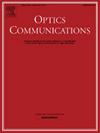Two-photon polymerization of hydrogel cellular scaffolds
IF 2.2
3区 物理与天体物理
Q2 OPTICS
引用次数: 0
Abstract
Three-dimensional (3D) micro-nano fabrication through two-photon polymerization (TPP) offers a convenient way to fabricate complex structures with fine precision using hydrogel materials commonly employed in biological cell culture. Presently, tissue engineering scaffold fabrication encounters challenges related to processing precision and the creation of complex structures. We developed a 780 nm fs laser system integrated with a 2D galvanometer system and Z-axis to create a 3D micro-nano printing system. Arbitrarily complex structures that simulate the vascular environment in vivo can be fabricated, taking advantage of the fact that the femtosecond laser is focused only inside the photoresist. Through testing the linewidth resolution of GelMA hydrogel via two-photon polymerization processing, we identified optimal laser power, scanning rate, and photoinitiator concentration for precise processing. We successfully produced a simple tissue scaffold, a regular structure composed of several cubes. A complex structure scaffold simulating the structure of mouse blood vessels was printed, and we successfully seeded the mouse neuron cells on it. This confirms the feasibility of replicating the in vivo vascular environment in vitro and utilizing two-photon micro-nano-processed scaffold structures for cell culture experiments. The ability to fabricate complex microstructures with high precision and resolution using GelMA hydrogel opens up new possibilities in tissue engineering, regenerative medicine, and drug delivery systems.
双光子聚合水凝胶细胞支架
通过双光子聚合(TPP)技术进行三维(3D)微纳制造,为使用生物细胞培养中常用的水凝胶材料精确制造复杂结构提供了一种便捷的方法。目前,组织工程支架的制造在加工精度和复杂结构的创建方面遇到了挑战。我们开发了一种 780 nm fs 激光系统,该系统与二维振镜系统和 Z 轴集成,可创建三维微纳打印系统。利用飞秒激光只聚焦在光刻胶内部的优势,可以制造出模拟体内血管环境的任意复杂结构。通过测试双光子聚合处理 GelMA 水凝胶的线宽分辨率,我们确定了精确处理所需的最佳激光功率、扫描速率和光引发剂浓度。我们成功制作了一个简单的组织支架,它是由多个立方体组成的规则结构。我们打印出了一个模拟小鼠血管结构的复杂结构支架,并成功地在上面播种了小鼠神经元细胞。这证实了在体外复制体内血管环境和利用双光子微纳加工支架结构进行细胞培养实验的可行性。利用 GelMA 水凝胶以高精度和高分辨率制造复杂微结构的能力为组织工程、再生医学和药物输送系统开辟了新的可能性。
本文章由计算机程序翻译,如有差异,请以英文原文为准。
求助全文
约1分钟内获得全文
求助全文
来源期刊

Optics Communications
物理-光学
CiteScore
5.10
自引率
8.30%
发文量
681
审稿时长
38 days
期刊介绍:
Optics Communications invites original and timely contributions containing new results in various fields of optics and photonics. The journal considers theoretical and experimental research in areas ranging from the fundamental properties of light to technological applications. Topics covered include classical and quantum optics, optical physics and light-matter interactions, lasers, imaging, guided-wave optics and optical information processing. Manuscripts should offer clear evidence of novelty and significance. Papers concentrating on mathematical and computational issues, with limited connection to optics, are not suitable for publication in the Journal. Similarly, small technical advances, or papers concerned only with engineering applications or issues of materials science fall outside the journal scope.
 求助内容:
求助内容: 应助结果提醒方式:
应助结果提醒方式:


